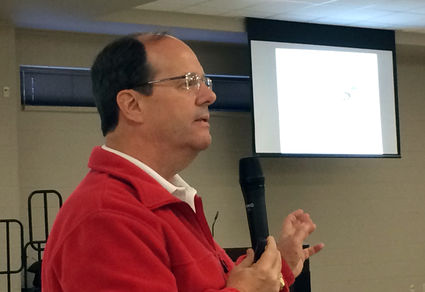SETRPC unveils area terrorist attack prepping
Last updated 12/4/2018 at Noon
Cutline: Kevin Clement of the University of Houston explains preparations that are being taken to protect Southeast Texans in the wake of a terrorist attack. RECORD Photo: Dave Rogers
Dave Rogers
For The Record
It isn’t anything fun to think about, but everybody needs to.
“A terrorist attack may never happen here, but you want to be prepared,” said Steve Curran, Complex Coordinated Terrorist Attack Preparedness Planner.
According to Tuesday’s briefing by the Southeast Texas Regional Planning Commission, we all should take time to educate ourselves what to watch for and how to react in the event of a CCTA.
“You hear that plans aren’t worth anything once the first shots have been fired, but when shots are being fired, you default to your planning,” said Kevin Clement, the University of Houston’s executive director for strategic partnerships.
“If you map it out in advance, and everybody agrees on the plan, then there shouldn’t be any question about it on that day.”
Tuesday’s 90-minute community briefing drew a gathering of first responders and local officials to the Orange County Convention and Expo Center.
Sue Landry, director of SETRPC’s criminal justice and security division, explained how the Beaumont-based council of government for Hardin, Jefferson and Orange counties was awarded a three-year, $1.1 million grant from the Department of Homeland Security in 2017. SETRPC partnered with the University of Houston to develop a Unified Regional Response to a Complex Coordinated Terrorist Attack.
The briefing covered Year 1 accomplishments, and goals for Years 2 and 3.
She said actual case studies and after-action reports from prior terrorist attacks – Paris, Boston, Aurora, Colo .; San Bernardino, Calif .; Orlando and others – were reviewed for preparedness suggestions.
Clement said workshops were held in 2018 about six functional areas: Public information, Tactical Response, Medical Response, Intelligence Workshop, Victims’ Support and Family Services, and Operational Communications and a Southeast Texas plan was begun.
Year 2 goals including fine-tuning the plan and conducting tabletop exercises for first responders, medical response and executive leaders.
Year 3 plans include an actual terrorist attack exercise involving all jurisdictions of the region.
“We’ve made great progress,” Curran said. “We’re breaking new ground.
“It’s not always easy to put all this stuff down in writing so you can actually have it when you’re out in the field. One thing you learn about terrorist tactics is they’re constantly changing.”
Kaylen Arendale, regional emergency planner, and Capt. James Riley of the Jefferson County Sheriff’s Office offered tips on individual preparedness.
Arendale urged community engagement and things like a bomb-making materials awareness program, so people are more informed and “see something, say something.”
“The best thing we can do is educate our citizens,” she said.
“What can you do to help? Being prepared is the best thing you can do to help your family.”
She suggested families put together a “go kit” of things needed for a quick move.
“Don’t forget to plan for the elderly and pets,” she said.
Riley notes that recent mass shootings in schools, malls and entertainment complexes have taught first responders that waiting around for a crisis negotiator is no longer the way to go.
“We go and stop the killing, that’s our main focus,” he said. “We’re not going to wait anymore, not since Columbine.”
Riley teaches a one-hour active shooter response class.
“My ultimate goal with schools: We have fire drills every six weeks; I wish we had active shooter drills every six weeks.”







Reader Comments(0)